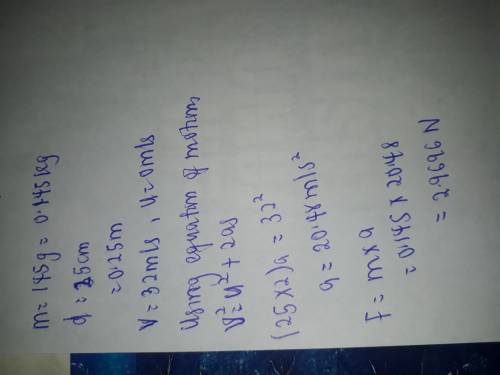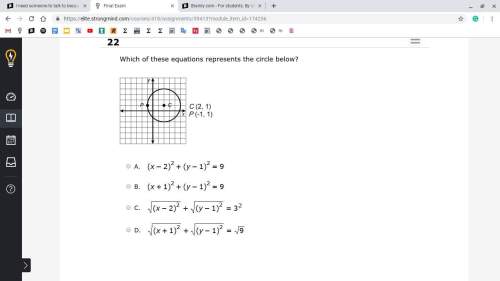
Mathematics, 03.03.2020 00:57 sarinaneedshelp01
(II) A baseball (m = 145 g) traveling 32 ms moves a fielder’s glove backward 25 cm when the ball is caught. What was the average force exerted by the ball on the glove?

Answers: 3
Another question on Mathematics

Mathematics, 21.06.2019 14:30
Aswimming pool has an input pump for filling the pool and an output pump for emptying the pool. the input pump can fill the pool in 3 hours, and the output pump can drain the pool in 5 hours. as you go to bed, the pool is full, but a neighbor’s kid turns on the output pump. at midnight, you awake to find the pool half empty. immediately, you turn on the input pump, but you are sleepy and forget to turn off the output pump. at what time will the pool become full?
Answers: 1

Mathematics, 21.06.2019 16:30
The angles below are supplementary. what is the value of x? a pair of supplementary angles is shown. one angle measures 7x + 33, and the other angle measures 70. 5.3 8.14 11 14.7
Answers: 1

Mathematics, 21.06.2019 22:30
Whats are the trickiest steps to do when adding or subtracting rational expressions? how does knowledge of rational numbers u in adding and subtracting rational expressions?
Answers: 2

Mathematics, 22.06.2019 03:00
In this problem, we explore the effect on the standard deviation of multiplying each data value in a data set by the same constant. consider the data set 14, 6, 8, 15, 15. (a) use the defining formula, the computation formula, or a calculator to compute s. (round your answer to one decimal place.) s = 4.28 (b) multiply each data value by 3 to obtain the new data set 42, 18, 24, 45, 45. compute s. (round your answer to one decimal place.) s = 12.83 (c) compare the results of parts (a) and (b). in general, how does the standard deviation change if each data value is multiplied by a constant c? multiplying each data value by the same constant c results in the standard deviation remaining the same. multiplying each data value by the same constant c results in the standard deviation being |c| times as large. multiplying each data value by the same constant c results in the standard deviation increasing by c units. multiplying each data value by the same constant c results in the standard deviation being |c| times smaller. (d) you recorded the weekly distances you bicycled in miles and computed the standard deviation to be s = 3.8 miles. your friend wants to know the standard deviation in kilometers. do you need to redo all the calculations? yes no given 1 mile ≠1.6 kilometers, what is the standard deviation in kilometers? (enter your answer to two decimal places.)
Answers: 1
You know the right answer?
(II) A baseball (m = 145 g) traveling 32 ms moves a fielder’s glove backward 25 cm when the ball is...
Questions

English, 24.04.2021 01:10



Physics, 24.04.2021 01:10



History, 24.04.2021 01:10

Business, 24.04.2021 01:10


History, 24.04.2021 01:10

Mathematics, 24.04.2021 01:10

Mathematics, 24.04.2021 01:10

Mathematics, 24.04.2021 01:10

Mathematics, 24.04.2021 01:10










